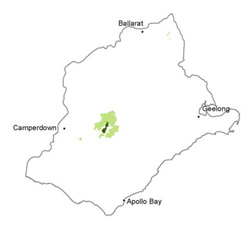41 Brown strongly structured gradational and uniform soils (earths and loams, including Ferrosols) on Quaternary basic volcanics
| These soils occur on basic volcanic deposits in well to imperfectly drained areas and positions, such as eruption point footslopes of associated scoria and ash deposits in both the south-west of the CMA and east of Ballarat in the Western Uplands, as well as scattered occurrences on the basaltic volcanic plains including many stony rises. These soils have moderately (moderate and fine) structured dark friable clay loam to light clay surface soils (10–50 cm depth) which may grade into a weakly structured clay loam to light clay subsurface horizon. This grades into a brown occasionally mottled clay loam to medium clay, which generally grade into the parent material at well over 100 cm (BD2, BD33) or shallower on stony rises or ash deposits (40–60 cm). Notable characteristics include: the gradational increase in clay content with depth, high clay content, weak structure (low pedality), slightly acidic to neutral pH, poorer soil drainage (occasional mottling), high free iron content, and high nutrient levels. |  |
Soil Sites
Site Code | Soil-landform unit | Component | ASC | FK | 1:100 000 mapsheet |
| Lower slope | Melanic, Eutrophic, Brown Ferrosol | Gn2.64 | T7622 - Ballarat | ||
| Terrace | Melanic, Eutrophic, Black Kandosol | Gn2.02 | T7622 - Ballarat | ||
| Flat | Humose-Acidic, Magnesic, Black Kandosol | Gn2.01 | T7520 - Princetown | ||
| Lower slope | Sodic, Eutrohpic, Brown Dermosol (Ferrosol?) | Gn3.22 | T7621 - Colac |


